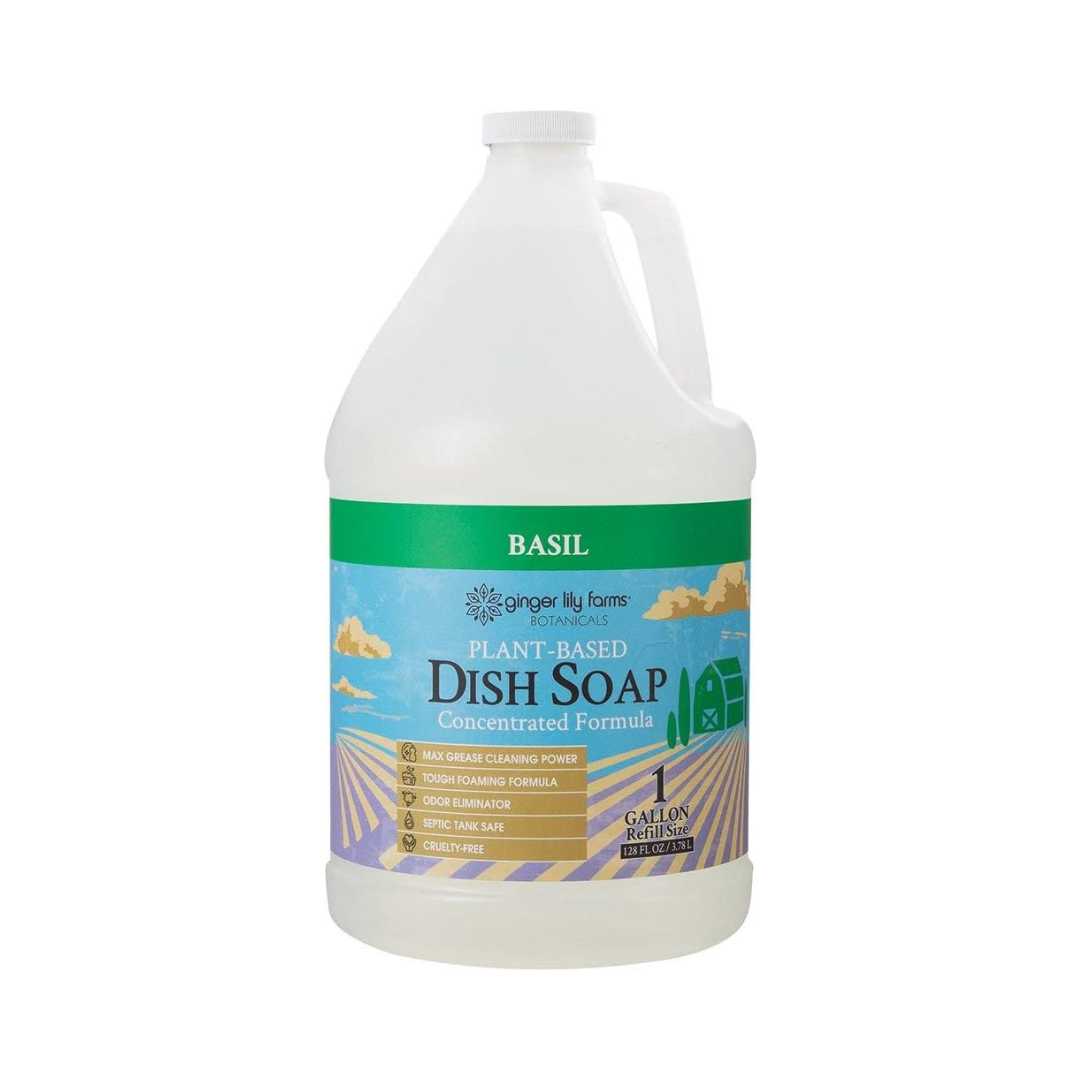
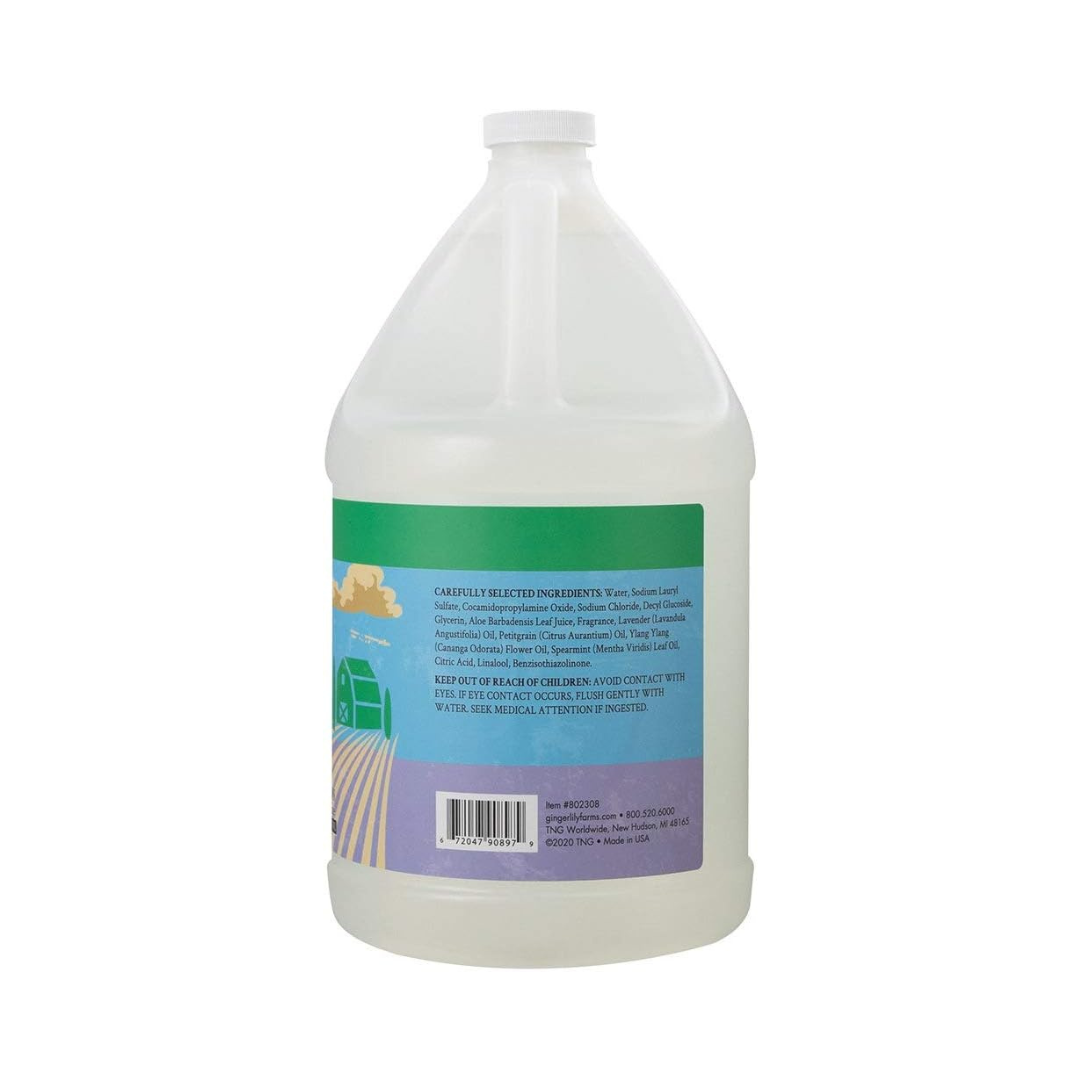
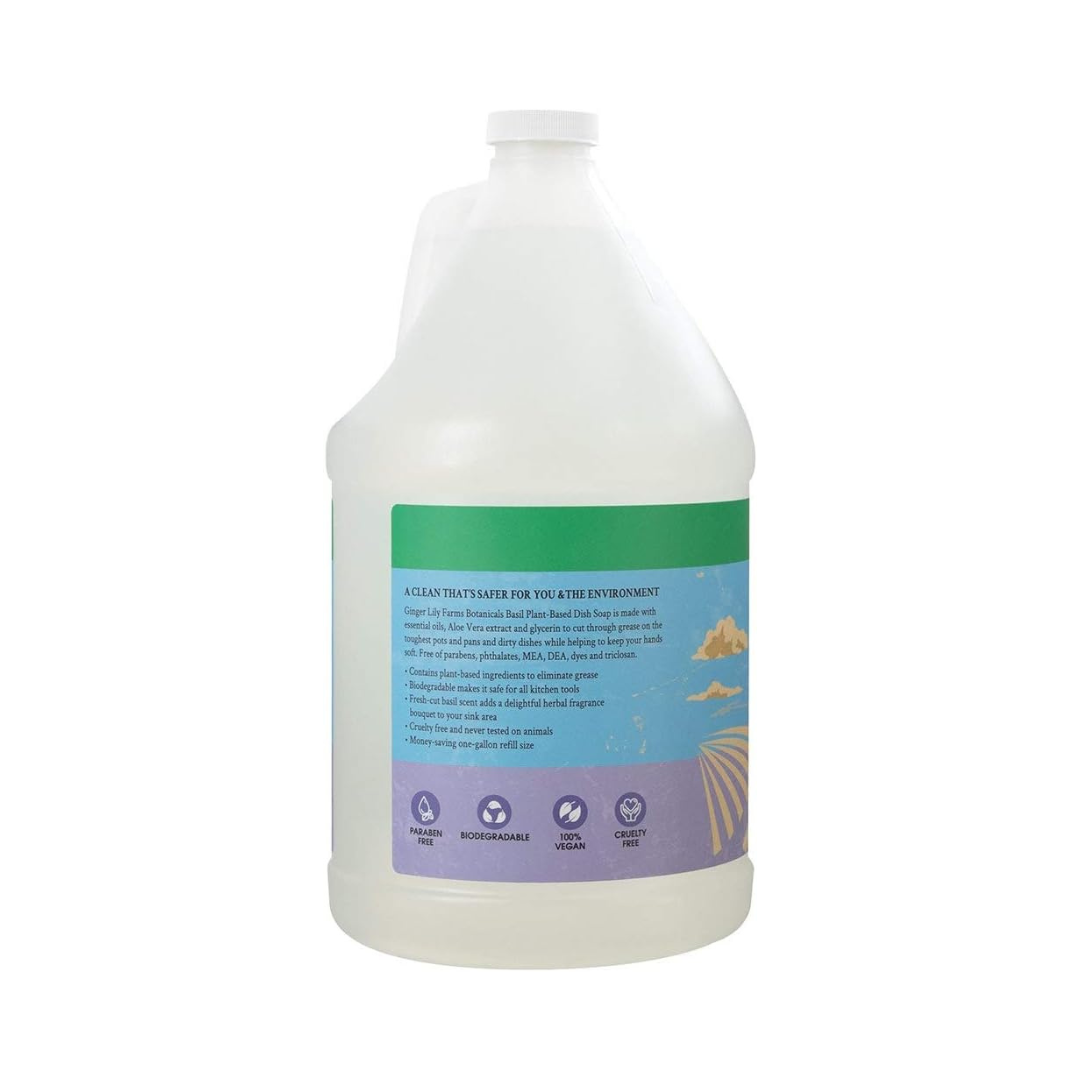
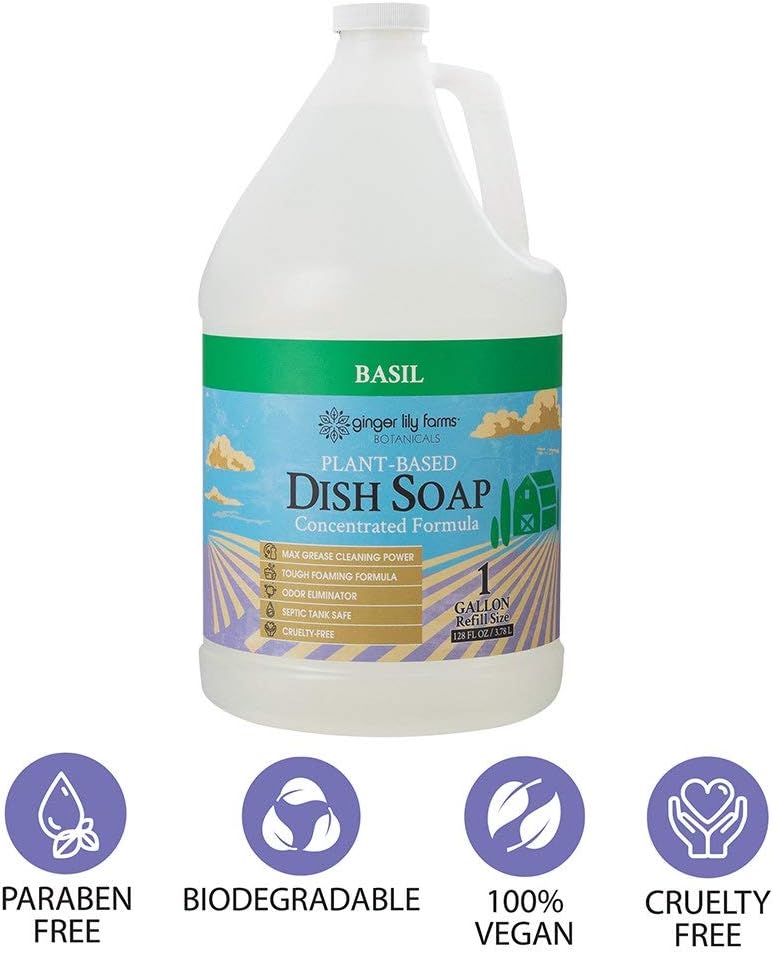
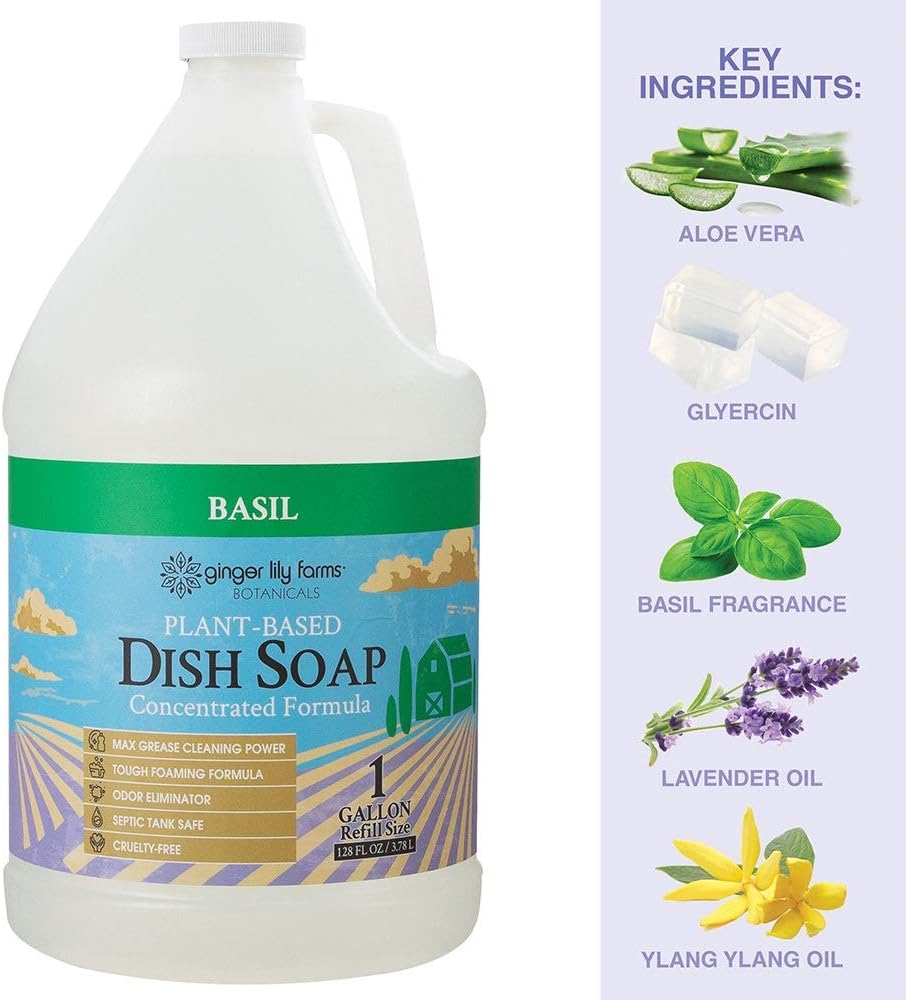
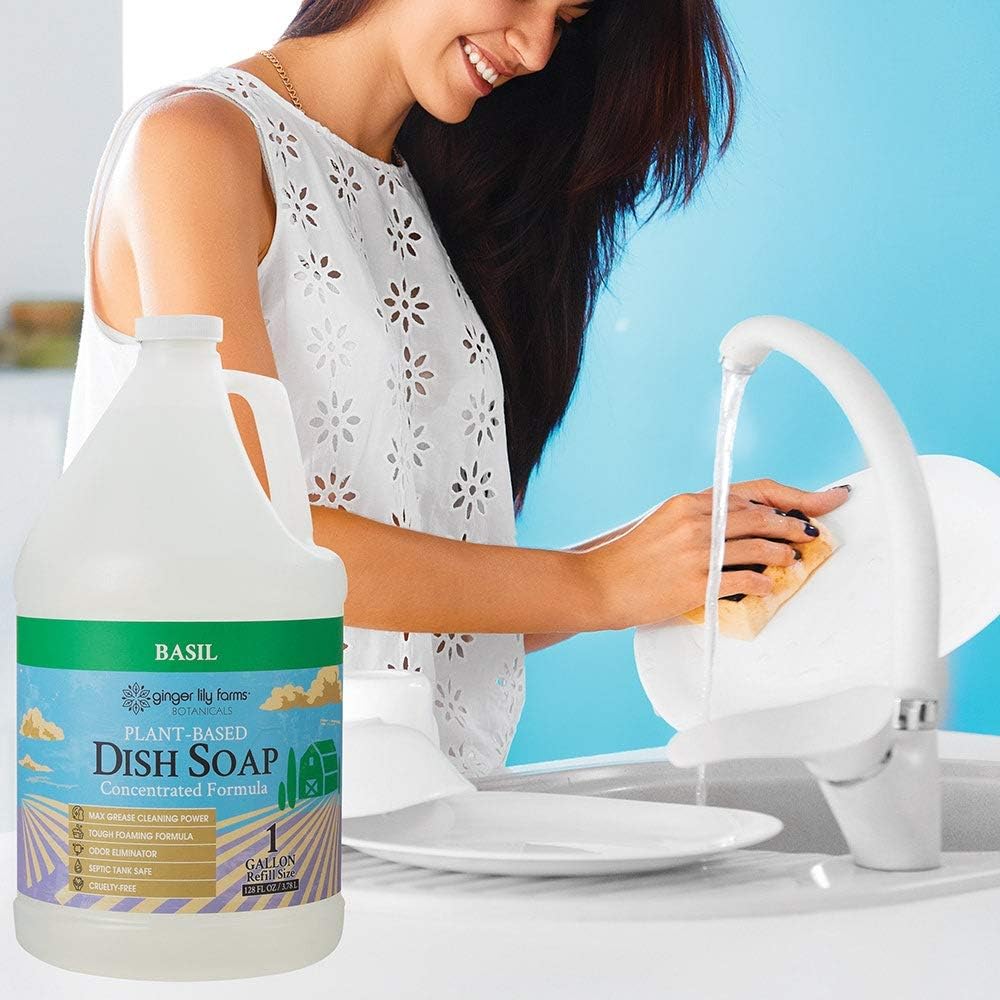
Ginger Lily Farms Dish Soap - Maximum Grease Cleaning Power, Plant-Based, Basil Scent - 1 Gallon


Fragrance
High RiskFragrance refers to a mixture of aromatic compounds used in products to provide scent. It is commonly listed as 'fragrance' or 'parfum' on product labels and can serve various functions, including enhancing user experience and masking undesirable odors.
Sustai Insights
Fragrance offers functional benefits by improving product appeal; however, it poses significant health risks, notably a high likelihood of causing allergies and allergic contact dermatitis. Environmental risks include potential pollution and endocrine disruption, though its overall carcinogenicity is low. Regulatory bodies have noted concerns regarding its use, leading to a high-risk classification. Safe usage practices should be observed, and alternatives such as natural essential oils are recommended for those sensitive to synthetic fragrances.
Linalool
High RiskLinalool is a terpene commonly found in various plants, particularly in lavender and mint. It is primarily used in products for its fragrance and potential antimicrobial properties. Linalool is also utilized in formulations for its ability to enhance the sensory experience of personal care and household products.
Sustai Insights
Linalool offers functional benefits as a naturally occurring fragrance component and may exhibit antimicrobial properties. However, it presents high allergenic potential, with concerns about skin irritation and sensitization. Environmental risks include contamination issues, though it is not classified as a persistent pollutant. Regulatory bodies have noted the need for careful handling due to its allergenic nature. Overall, despite some beneficial attributes, the ingredient carries a high risk profile, warranting cautious use and consideration of safer alternatives.
Benzisothiazolinone
High RiskBenzisothiazolinone is a heterocyclic compound commonly used as a preservative in various products due to its effectiveness in preventing microbial growth. It is often found in paints, coatings, and personal care items.
Sustai Insights
Benzisothiazolinone serves effectively as a preservative, inhibiting bacterial and fungal growth, which prolongs product shelf life. However, it is associated with moderate allergenic potential and has high use restrictions due to regulatory concerns. Environmental risks include its classification as a pollutant, with potential bioaccumulation. Regulatory bodies have flagged it for unacceptable use levels in verified products, leading to an overall high-risk assessment. Safe usage practices are essential, and alternatives such as natural preservatives may be considered.
Picea Mariana Leaf Oil
High RiskPicea mariana leaf oil, derived from the needles of the black spruce tree, is commonly used in personal care products for its aromatic properties and potential skin benefits. It functions primarily as a fragrance component and may also have preservative qualities due to its natural antimicrobial properties.
Sustai Insights
Picea mariana leaf oil offers functional benefits as a natural fragrance and potential antimicrobial agent, which can enhance product stability. However, it carries high usage restrictions and is associated with low risk for carcinogenicity, allergies, and reproductive toxicity. Environmental concerns include potential pollution and bioaccumulation. Regulatory warnings indicate heightened caution in use. Overall, the ingredient presents a high risk assessment, and users are advised to consider safer alternatives or limit exposure.
Citric Acid
Medium RiskCitric acid is an alpha hydroxy acid used in personal care products primarily for its role as a pH adjuster and natural preservative. It occurs naturally in citrus fruits and is commonly utilized in various formulations for its chelating properties and mild exfoliation benefits.
Sustai Insights
Citric acid offers functional benefits as an effective preservative and pH stabilizer, contributing to product longevity and stability. It is biodegradable and derived from renewable sources. Health risks are low, with minimal concerns regarding carcinogenicity, allergies, and reproductive toxicity. However, moderate use restrictions exist due to potential irritation at high concentrations. Environmental risks are limited, as citric acid is not known to accumulate in ecosystems. Regulatory agencies have no significant advisories against its use. Overall, it is assessed as a medium-risk ingredient, with safe usage practices recommended and alternatives available.
Citrus Aurantium Amara (Bitter Orange) Peel Oil
Medium RiskCitrus aurantium amara (bitter orange) peel oil is an essential oil extracted from the peels of the bitter orange fruit. It is often used for its aromatic properties and as a natural flavoring agent in various products, including cosmetics and food items.
Sustai Insights
Bitter orange peel oil offers functional benefits as a natural fragrance and may possess antimicrobial properties. However, it has a high allergenic potential, posing risks such as skin irritation and allergic reactions. Its environmental impact includes moderate persistence and potential for bioaccumulation. Regulatory restrictions exist for certain uses, leading to a medium risk assessment overall. Safe usage practices should be followed, and alternatives include other essential oils with lower allergenic profiles.
Water
Low RiskWater is a clear, colorless liquid essential for various biological processes. It serves as a solvent in formulations, facilitating the dissolution of other ingredients and enhancing product texture and application. Additionally, water plays a crucial role in hydration and is a key component in many cosmetic and personal care products.
Sustai Insights
Water is an effective solvent and hydrator, contributing to the texture and efficacy of formulations. It is biodegradable and generally regarded as safe, with low concerns regarding carcinogenicity, allergies, and reproductive toxicity. However, excessive water usage can lead to environmental concerns, particularly regarding resource depletion. Regulatory bodies do not impose restrictions on water use in cosmetics. Overall, the risks associated with water are low, making it a safe and essential ingredient.
Decyl Glucoside
Low RiskDecyl glucoside is a glucose-based surfactant derived from natural sources, primarily used as a mild cleansing agent in personal care products. It effectively reduces surface tension, allowing for improved mixing of ingredients and enhanced cleansing properties without stripping natural oils from the skin.
Sustai Insights
Decyl glucoside offers functional benefits as a non-ionic surfactant, making it suitable for sensitive skin formulations. It is biodegradable and derived from renewable resources, supporting sustainability. Health risks are primarily low, with minimal concerns regarding irritation and allergies. Environmental risks are low, as it does not significantly contribute to pollution or bioaccumulation. Regulatory status is generally favorable, with low restrictions noted. Overall, decyl glucoside presents a low risk for use in consumer products, making it a suitable choice for gentle formulations.
Sodium Lauryl Sulfate
Low RiskSodium lauryl sulfate is the sodium salt of lauryl sulfuric acid, commonly used as a surfactant in various personal care and cleaning products. It functions primarily to create lather and reduce surface tension, facilitating the distribution of other ingredients.
Sustai Insights
Sodium lauryl sulfate effectively serves as a surfactant, enhancing product performance in cleansing formulations. It is generally considered to have low health risks, with minimal concerns regarding carcinogenicity, allergy, or reproductive toxicity. Environmental impact is also low, as it is not classified as a bioaccumulative pollutant. Regulatory bodies, including the FDA, impose no significant restrictions on its use. Safe usage practices should still be observed to minimize skin irritation. Overall, sodium lauryl sulfate is assessed as low risk, with alternatives like sodium coco sulfate available for those seeking more sustainable options.
Sea Salt
Low RiskSea salt is a mixture of inorganic salts derived primarily from the evaporation of seawater. It consists mainly of sodium chloride, with minor amounts of other minerals. Sea salt is commonly used as a seasoning and preservative in food products and may also have applications in cosmetics and personal care items.
Sustai Insights
Sea salt serves as an effective flavor enhancer and preservative, contributing to the taste and shelf-life of food products. It is generally considered safe with low risk for health concerns such as cancer, allergies, and reproductive toxicity. Environmental impact is minimal, as it does not contribute significantly to pollution or bioaccumulation. Regulatory bodies, including the FDA, currently do not impose restrictions on its use. Overall, the risk level associated with sea salt is low, making it a widely accepted ingredient with no significant adverse effects reported.
Vegetarian Glycerin
Low RiskVegetarian glycerin, also known as glycerol, is a colorless, odorless, and viscous liquid derived from plant sources. It is primarily used as a humectant, solvent, and emollient in various personal care products, helping to retain moisture and improve texture.
Sustai Insights
Vegetarian glycerin offers functional benefits as an effective humectant, promoting hydration and skin smoothness. It is biodegradable and typically sustainably sourced. Health risks associated with glycerin are low, with no significant concerns for carcinogenicity, allergens, or reproductive toxicity. Environmental risks are minimal, and it is not subject to major regulatory warnings. Overall, the risk level for this ingredient is low, making it a safe choice in formulations. Safe usage practices include ensuring proper concentrations in products, and alternatives such as propylene glycol exist but may have differing properties.
Cocamidopropylamine Oxide
Low RiskCocamidopropylamine oxide is a tertiary amine derived from coconut oil, commonly used as a surfactant and foam booster in cosmetic and personal care products. It helps enhance the cleansing properties of formulations and improves the texture of products such as shampoos and body washes.
Sustai Insights
Cocamidopropylamine oxide offers functional benefits as an effective surfactant, enhancing product performance while being derived from renewable coconut sources, which supports sustainability. Health risks are minimal, with low concerns regarding carcinogenicity, allergies, or reproductive toxicity. Environmental risks are also low, with no significant pollutant potential noted. Regulatory assessments indicate no severe restrictions. Overall, this ingredient is considered low risk, promoting safe use in personal care formulations.
Fragrance
High RiskFragrance refers to a mixture of aromatic compounds used in products to provide scent. It is commonly listed as 'fragrance' or 'parfum' on product labels and can serve various functions, including enhancing user experience and masking undesirable odors.
Sustai Insights
Fragrance offers functional benefits by improving product appeal; however, it poses significant health risks, notably a high likelihood of causing allergies and allergic contact dermatitis. Environmental risks include potential pollution and endocrine disruption, though its overall carcinogenicity is low. Regulatory bodies have noted concerns regarding its use, leading to a high-risk classification. Safe usage practices should be observed, and alternatives such as natural essential oils are recommended for those sensitive to synthetic fragrances.
Linalool
High RiskLinalool is a terpene commonly found in various plants, particularly in lavender and mint. It is primarily used in products for its fragrance and potential antimicrobial properties. Linalool is also utilized in formulations for its ability to enhance the sensory experience of personal care and household products.
Sustai Insights
Linalool offers functional benefits as a naturally occurring fragrance component and may exhibit antimicrobial properties. However, it presents high allergenic potential, with concerns about skin irritation and sensitization. Environmental risks include contamination issues, though it is not classified as a persistent pollutant. Regulatory bodies have noted the need for careful handling due to its allergenic nature. Overall, despite some beneficial attributes, the ingredient carries a high risk profile, warranting cautious use and consideration of safer alternatives.
Water
Low RiskWater is a clear, colorless liquid essential for various biological processes. It serves as a solvent in formulations, facilitating the dissolution of other ingredients and enhancing product texture and application. Additionally, water plays a crucial role in hydration and is a key component in many cosmetic and personal care products.
Sustai Insights
Water is an effective solvent and hydrator, contributing to the texture and efficacy of formulations. It is biodegradable and generally regarded as safe, with low concerns regarding carcinogenicity, allergies, and reproductive toxicity. However, excessive water usage can lead to environmental concerns, particularly regarding resource depletion. Regulatory bodies do not impose restrictions on water use in cosmetics. Overall, the risks associated with water are low, making it a safe and essential ingredient.
Benzisothiazolinone
High RiskBenzisothiazolinone is a heterocyclic compound commonly used as a preservative in various products due to its effectiveness in preventing microbial growth. It is often found in paints, coatings, and personal care items.
Sustai Insights
Benzisothiazolinone serves effectively as a preservative, inhibiting bacterial and fungal growth, which prolongs product shelf life. However, it is associated with moderate allergenic potential and has high use restrictions due to regulatory concerns. Environmental risks include its classification as a pollutant, with potential bioaccumulation. Regulatory bodies have flagged it for unacceptable use levels in verified products, leading to an overall high-risk assessment. Safe usage practices are essential, and alternatives such as natural preservatives may be considered.
Picea Mariana Leaf Oil
High RiskPicea mariana leaf oil, derived from the needles of the black spruce tree, is commonly used in personal care products for its aromatic properties and potential skin benefits. It functions primarily as a fragrance component and may also have preservative qualities due to its natural antimicrobial properties.
Sustai Insights
Picea mariana leaf oil offers functional benefits as a natural fragrance and potential antimicrobial agent, which can enhance product stability. However, it carries high usage restrictions and is associated with low risk for carcinogenicity, allergies, and reproductive toxicity. Environmental concerns include potential pollution and bioaccumulation. Regulatory warnings indicate heightened caution in use. Overall, the ingredient presents a high risk assessment, and users are advised to consider safer alternatives or limit exposure.
Citric Acid
Medium RiskCitric acid is an alpha hydroxy acid used in personal care products primarily for its role as a pH adjuster and natural preservative. It occurs naturally in citrus fruits and is commonly utilized in various formulations for its chelating properties and mild exfoliation benefits.
Sustai Insights
Citric acid offers functional benefits as an effective preservative and pH stabilizer, contributing to product longevity and stability. It is biodegradable and derived from renewable sources. Health risks are low, with minimal concerns regarding carcinogenicity, allergies, and reproductive toxicity. However, moderate use restrictions exist due to potential irritation at high concentrations. Environmental risks are limited, as citric acid is not known to accumulate in ecosystems. Regulatory agencies have no significant advisories against its use. Overall, it is assessed as a medium-risk ingredient, with safe usage practices recommended and alternatives available.
Decyl Glucoside
Low RiskDecyl glucoside is a glucose-based surfactant derived from natural sources, primarily used as a mild cleansing agent in personal care products. It effectively reduces surface tension, allowing for improved mixing of ingredients and enhanced cleansing properties without stripping natural oils from the skin.
Sustai Insights
Decyl glucoside offers functional benefits as a non-ionic surfactant, making it suitable for sensitive skin formulations. It is biodegradable and derived from renewable resources, supporting sustainability. Health risks are primarily low, with minimal concerns regarding irritation and allergies. Environmental risks are low, as it does not significantly contribute to pollution or bioaccumulation. Regulatory status is generally favorable, with low restrictions noted. Overall, decyl glucoside presents a low risk for use in consumer products, making it a suitable choice for gentle formulations.
Sodium Lauryl Sulfate
Low RiskSodium lauryl sulfate is the sodium salt of lauryl sulfuric acid, commonly used as a surfactant in various personal care and cleaning products. It functions primarily to create lather and reduce surface tension, facilitating the distribution of other ingredients.
Sustai Insights
Sodium lauryl sulfate effectively serves as a surfactant, enhancing product performance in cleansing formulations. It is generally considered to have low health risks, with minimal concerns regarding carcinogenicity, allergy, or reproductive toxicity. Environmental impact is also low, as it is not classified as a bioaccumulative pollutant. Regulatory bodies, including the FDA, impose no significant restrictions on its use. Safe usage practices should still be observed to minimize skin irritation. Overall, sodium lauryl sulfate is assessed as low risk, with alternatives like sodium coco sulfate available for those seeking more sustainable options.
Sea Salt
Low RiskSea salt is a mixture of inorganic salts derived primarily from the evaporation of seawater. It consists mainly of sodium chloride, with minor amounts of other minerals. Sea salt is commonly used as a seasoning and preservative in food products and may also have applications in cosmetics and personal care items.
Sustai Insights
Sea salt serves as an effective flavor enhancer and preservative, contributing to the taste and shelf-life of food products. It is generally considered safe with low risk for health concerns such as cancer, allergies, and reproductive toxicity. Environmental impact is minimal, as it does not contribute significantly to pollution or bioaccumulation. Regulatory bodies, including the FDA, currently do not impose restrictions on its use. Overall, the risk level associated with sea salt is low, making it a widely accepted ingredient with no significant adverse effects reported.
Vegetarian Glycerin
Low RiskVegetarian glycerin, also known as glycerol, is a colorless, odorless, and viscous liquid derived from plant sources. It is primarily used as a humectant, solvent, and emollient in various personal care products, helping to retain moisture and improve texture.
Sustai Insights
Vegetarian glycerin offers functional benefits as an effective humectant, promoting hydration and skin smoothness. It is biodegradable and typically sustainably sourced. Health risks associated with glycerin are low, with no significant concerns for carcinogenicity, allergens, or reproductive toxicity. Environmental risks are minimal, and it is not subject to major regulatory warnings. Overall, the risk level for this ingredient is low, making it a safe choice in formulations. Safe usage practices include ensuring proper concentrations in products, and alternatives such as propylene glycol exist but may have differing properties.
Cocamidopropylamine Oxide
Low RiskCocamidopropylamine oxide is a tertiary amine derived from coconut oil, commonly used as a surfactant and foam booster in cosmetic and personal care products. It helps enhance the cleansing properties of formulations and improves the texture of products such as shampoos and body washes.
Sustai Insights
Cocamidopropylamine oxide offers functional benefits as an effective surfactant, enhancing product performance while being derived from renewable coconut sources, which supports sustainability. Health risks are minimal, with low concerns regarding carcinogenicity, allergies, or reproductive toxicity. Environmental risks are also low, with no significant pollutant potential noted. Regulatory assessments indicate no severe restrictions. Overall, this ingredient is considered low risk, promoting safe use in personal care formulations.
Citrus Aurantium Amara (Bitter Orange) Peel Oil
Medium RiskCitrus aurantium amara (bitter orange) peel oil is an essential oil extracted from the peels of the bitter orange fruit. It is often used for its aromatic properties and as a natural flavoring agent in various products, including cosmetics and food items.
Sustai Insights
Bitter orange peel oil offers functional benefits as a natural fragrance and may possess antimicrobial properties. However, it has a high allergenic potential, posing risks such as skin irritation and allergic reactions. Its environmental impact includes moderate persistence and potential for bioaccumulation. Regulatory restrictions exist for certain uses, leading to a medium risk assessment overall. Safe usage practices should be followed, and alternatives include other essential oils with lower allergenic profiles.
Discover the power of Ginger Lily Farms Botanicals Plant-Based Liquid Dish Soap, a concentrated formula designed to tackle tough grease while being gentle on your skin and the environment. This 1-gallon refill not only reduces plastic waste but also elevates your dishwashing experience with its refreshing basil scent.
- Maximum Grease Cleaning Power: Effectively cuts through the toughest grease, ensuring your dishes, pots, and pans shine.
- Plant-Based Formula: Crafted with plant-based ingredients, this dish soap is tough on grime but gentle on your skin.
- Biodegradable Dish Soap: Composed of essential oils and Aloe Vera, this paraben-free formula is safe for all kitchen utensils, free from harmful chemicals.
- Clean and Refreshing Ingredients: Infused with fresh-cut basil, it adds a delightful herbal fragrance that transforms your kitchen into a fragrant haven.
- Economical & Eco-Friendly: This 1-gallon refill size is perfect for reducing plastic consumption and is ideal for home use or commercial settings.
Subscribe & Save with Sustai
- Best Price Guarantee: Always enjoy the lowest prices on sustainable home essentials.
- No Surprises: We’ll notify you before shipping. No hidden fees, ever.
- You’re in Charge: Change, pause, or cancel your subscription anytime with ease.
- Eco-Friendly Deliveries: Our grouped shipments mean less packaging and lower emissions.
Join us on a sustainable journey. Special offers for a limited time! Prices and promotions may change.
Recommended Products
Discover the power of Ginger Lily Farms Botanicals Plant-Based Liquid Dish Soap, a concentrated formula designed to tackle tough grease while being gentle on your skin and the environment. This 1-gallon refill not only reduces plastic waste but also elevates your dishwashing experience with its refreshing basil scent.
- Maximum Grease Cleaning Power: Effectively cuts through the toughest grease, ensuring your dishes, pots, and pans shine.
- Plant-Based Formula: Crafted with plant-based ingredients, this dish soap is tough on grime but gentle on your skin.
- Biodegradable Dish Soap: Composed of essential oils and Aloe Vera, this paraben-free formula is safe for all kitchen utensils, free from harmful chemicals.
- Clean and Refreshing Ingredients: Infused with fresh-cut basil, it adds a delightful herbal fragrance that transforms your kitchen into a fragrant haven.
- Economical & Eco-Friendly: This 1-gallon refill size is perfect for reducing plastic consumption and is ideal for home use or commercial settings.

You can have at most 2 Sustainable Steals products in your cart
Customer Reviews
Customers’ View
Customers appreciate the effectiveness and eco-friendly nature of the Ginger Lily Farms Botanicals Liquid Dish Soap. Many users praise its maximum grease-cutting ability, noting that it cleans well, even against tough stains like tomato sauce, while being gentle on the skin. The fresh basil scent is frequently mentioned as pleasant and refreshing, enhancing the overall dishwashing experience. Additionally, consumers value its plant-based and biodegradable formulation, which they see as a responsible choice for both their family and the environment. However, some feedback indicates mixed feelings regarding the product's durability, with a few mentioning that the suds may not last as long as expected. Overall, customers find this dish soap to be a reliable and eco-conscious option for their cleaning needs.
AI-generated from the text of customer reviewsThis product is rated 4.6 of 5.0 stars.
It has received 101 reviews.




